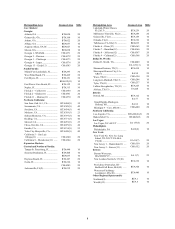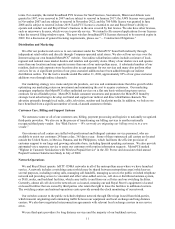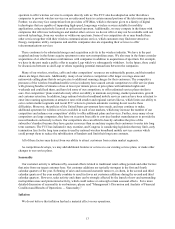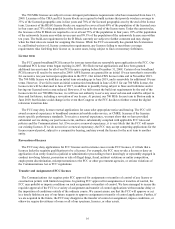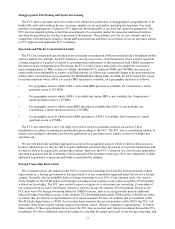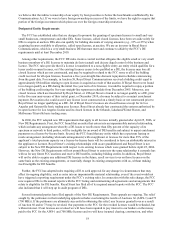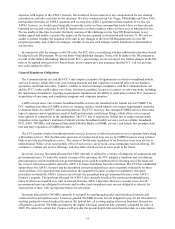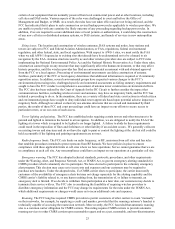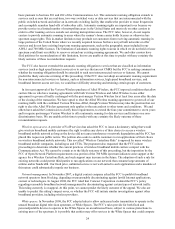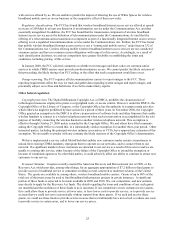Metro PCS 2008 Annual Report Download - page 24
Download and view the complete annual report
Please find page 24 of the 2008 Metro PCS annual report below. You can navigate through the pages in the report by either clicking on the pages listed below, or by using the keyword search tool below to find specific information within the annual report.15
AWS-1 spectrum. In 2006, the FCC assigned 90 MHz of spectrum to be used for advanced wireless services, or
AWS. The FCC divided the 90 MHz of spectrum into two 10 MHz and one 20 MHz paired blocks assigned on a
regional economic area grouping, or REAG, basis; one 10 MHz and one 20 MHz paired blocks each assigned on an
economic area, or EA, basis; and a 20 MHz paired block assigned on a Cellular Marketing Area, or CMA, basis. The
CMAs generally correspond to MSAs and RSAs. Under the AWS band plan, the United States is divided into 176
EAs, 12 REAGs, and 734 CMAs. The EAs are geographic areas defined by the Regional Economic Analysis
Division of the Bureau of Economic Analysis, U.S. Department of Commerce, as supplemented by the FCC.
REAGs are collections of EAs.
700 MHz spectrum. In 2008, the FCC assigned 62 MHz of spectrum in the 700 MHz band. The FCC divided the
62 MHz of spectrum into two 12 MHz paired blocks and one 6 MHz unpaired block licensed on a CMA or EA
basis; one 22 MHz paired block licensed on a REAG basis, and one 10 MHz paired block, or D Block, assigned on a
nationwide basis to be used as part of a private/public safety partnership. The holders of the 22 MHz licenses, most
of which are held by Verizon Wireless, must provide a network platform that is generally open to third-party
wireless devices and applications, or an Open Network Platform, by allowing consumers to use the handset of their
choice and to download and use the applications of their choice, subject to certain network management conditions
that are intended to allow the licensee to protect the network from harm. As originally allocated, the D Block
licensee was required to fund the construction of a nationwide interoperable broadband network for public safety on
a nationwide public safety license and to provide public safety with priority access during emergencies to the D
Block owned by the licensee. The D Block remained unpurchased at auction, and the FCC currently is considering
revisions to the auction and service rules that will apply to this license.
BRS spectrum. In 2004, the FCC ordered that the 2496-2690 MHz band, or the 2.5 GHz band, be reconfigured
over a period of time into upper and lower-band segments for low-power operations, with a mid-band segment for
high-power operations. This spectrum is allocated and licensed in the United States and its possessions and
territories in 493 BTAs. The Commission concluded in 2008 that 55.5 MHz of the broadband radio service, or BRS,
spectrum holdings in the 2.5 GHz band will be included in the Commission’s product market for mobile
telephony/broadband services, and taken into consideration when the Commission is assessing the competitive
impact of broadband wireless merger and acquisition transactions.
Future allocations. The FCC also has other broadband wireless spectrum allocation proceedings in process. For
example, the FCC is considering service rules for an additional 20 MHz of paired AWS spectrum, or AWS-2, in the
1915-1920 MHz, 1995-2000 MHz, 2020-2025 MHz and 2175-2180 MHz bands, as well as 20 MHz of unpaired
AWS spectrum, or AWS-3, in the 2155-2175 MHz band. Both AWS-2 and AWS-3 have been allocated for
advanced fixed and mobile services, including AWS. As noted above, the FCC also is seeking further comment on
service rules for the 700 MHz D Block. The FCC and interested parties have proposed that these blocks of spectrum
be subject to various conditions, configurations and terms and conditions. We cannot predict with any certainty the
likely configuration, conditions or timing of these proposed allocations, or the usability of any of this spectrum for
wireless services competitive with our services or by us. Congress, the federal government, and the FCC also may
pass legislation or undertake actions or proceedings in the future to allocate additional spectrum for wireless services
or to change the rules relating to already licensed spectrum which may allow new or existing licensees to provide
services comparable to the services we provide.
Construction obligations
The FCC has established various construction obligations for wireless licenses with different requirements often
applying to spectrum licensed at different points in time. For example, broadband PCS licensees holding licenses
originally granted as 30 MHz licenses must construct facilities to provide service covering one-third of the
population of the licensed area within five years, and two-thirds of the population of the licensed area within ten
years, or otherwise provide substantial service to the licensed area within the appropriate five- and ten-year
benchmarks, of their initial license grant date. Broadband PCS licensees holding 10 MHz and 15 MHz licenses
generally must construct facilities to provide service to 25% of the licensed area within five years of their initial
license grant date, or otherwise make a showing of substantial service. The FCC defines substantial service as
service which is sound, favorable and substantially above a mediocre service level only minimally warranting
renewal. Either we or the previous licensee satisfied the applicable five-year coverage requirement for each of our
broadband PCS licenses and the ten-year requirement for those PCS licenses that have already been renewed. All
AWS licensees will be required to construct facilities to provide substantial service by the end of the initial 15-year
license term. The initial 15-year license term for our AWS licenses does not expire until November 2021.





